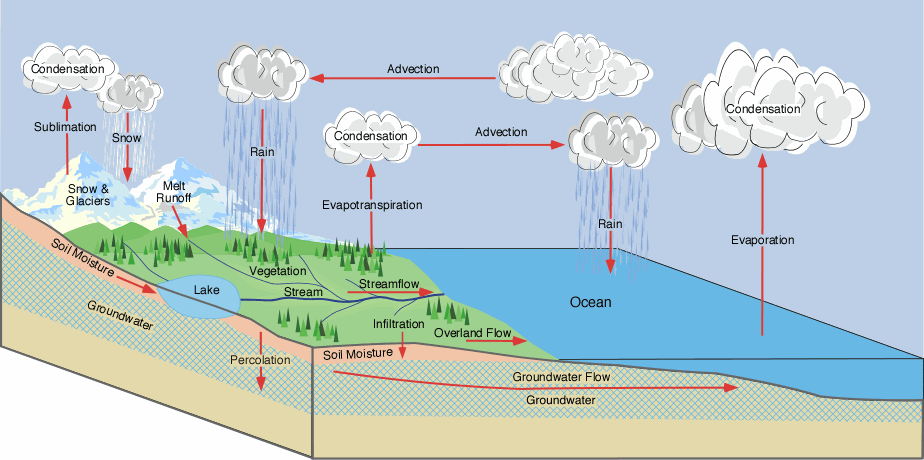The hydrologic cycle is a conceptual model that describes the storage and movement of water between the biosphere, atmosphere, lithosphere, and the hydrosphere (see Figure 8b-1). Water on this planet can be stored in any one of the following reservoirs: atmosphere, oceans, lakes, rivers, soils, glaciers, snowfields, and groundwater.

Figure 8b-1: Hydrologic Cycle.
Water moves from one reservoir to another by way of processes like evaporation, condensation, precipitation, deposition, runoff, infiltration,sublimation, transpiration, melting, and groundwater flow. The oceans supply most of the evaporated water found in the atmosphere. Of this evaporated water, only 91% of it is returned to the ocean basins by way of precipitation. The remaining 9% is transported to areas over landmasses where climatological factors induce the formation of precipitation. The resulting imbalance between rates of evaporation and precipitation over land and ocean is corrected by runoff and groundwater flow to the oceans.
The planetary water supply is dominated by the oceans (see Table 8b-1). Approximately 97% of all the water on the Earth is in the oceans. The other 3% is held as freshwater in glaciers and icecaps, groundwater, lakes, soil, the atmosphere, and within life.
Table 8b-1: Inventory of water at the Earth's surface.
| Reservoir |
Volume (cubic km x 1,000,000)
|
Percent of Total
|
| Oceans |
1370
|
97.25
|
| Ice Caps and Glaciers |
29
|
2.05
|
| Groundwater |
9.5
|
0.68
|
| Lakes |
0.125
|
0.01
|
| Soil Moisture |
0.065
|
0.005
|
| Atmosphere |
0.013
|
0.001
|
| Streams and Rivers |
0.0017
|
0.0001
|
Biosphere
|
0.0006
|
0.00004
|
Water is continually cycled between its various reservoirs. This cycling occurs through the processes of evaporation, condensation,precipitation, deposition, runoff, infiltration, sublimation, transpiration, melting, and groundwater flow. Table 8b-2 describes the ty[ical residence times of water in the major reservoirs. On average water is renewed in rivers once every 16 days. Water in the atmosphere is completely replaced once every 8 days. Slower rates of replacement occur in large lakes, glaciers, ocean bodies and groundwater. Replacement in these reservoirs can take from hundreds to thousands of years. Some of these resources (especially groundwater) are being used by humans at rates that far exceed their renewal times. This type of resource use is making this type of water effectively nonrenewable.
Table 8b-2: Typical residence times of water found in various reserviors.
Reservoir
|
Average Residence Time
|
| Glaciers |
20 to 100 years
|
| Seasonal Snow Cover |
2 to 6 months
|
| Soil Moisture |
1 to 2 months
|
| Groundwater: Shallow |
100 to 200 years
|
| Groundwater: Deep |
10,000 years
|
| Lakes |
50 to 100 years
|
| Rivers |
2 to 6 months
|
CITATION
Pidwirny, M. (2006). "The Hydrologic Cycle". Fundamentals of Physical Geography, 2nd Edition. 10/1/2012. http://www.physicalgeography.net/fundamentals/8b.html
Do you like this post? Please link back to this article by copying one of the codes below.
URL: HTML link code: BB (forum) link code: